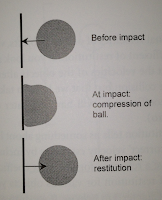Projectile motion can be defined as "The motion of an object projected at an angle into the air." (Blazevich, 2010.) To ensure the greatest range the batter needs to hit the ball at an appropriate angle. If the object is projected at a 90 degree or 70 degree angle it will be too steep and the ball will not have enough horizontal velocity to overcome the effects of gravity and it will fall too short. On the other hand if the object is projected at a smaller angle at about 30 degrees it will not have enough vertical velocity to reach sufficient range (Blazevich, 2010). In baseball this guide for estimating the projectile of an object is greatly affected by a number of different factors such as speed of the ball, speed of the bat, amount of undercut on the ball, and whether there is a top spin or back spin produced on the ball. When batting in baseball the release height is relatively the same for all shots as the pitcher is required to throw the ball between the shoulders and knees. A study shown by Sawicki et al. (2003) a number of parameters were varied and the results showed that the optimum release angles from the optimally batted balls varied slightly from 26.3 to 24.3 degrees.
References
Adair, R. (2002). The physics of baseball. New York: Harper.
Blazevich, A. J. (2010). Sport
Biomechanics The Basics: Optimising Human Performance. London: A&C
Black Publishers.
DeRenne, C. (1993). High-tech hitting: science vs. tradition. St. Paul:
West.
Fortenbaugh, D. (2011). Biomechanics of the Baseball Swing. International Journal of Sports
Biomechanics, 9(3), 170-249.
Nathan, A. M., Smith, L.V. (2010) Effect of ball Properties on the
Ball-Bat Coefficient of Restitution. 1-6.
Sawicki, G. S., Hubbard, M., Stronge, W. J. (2003). How to hit home
runs: Optimum baseball bat swing parameters for maximum range trajectories.
American Journal of Physics, 71 (11), 1152-1161.


